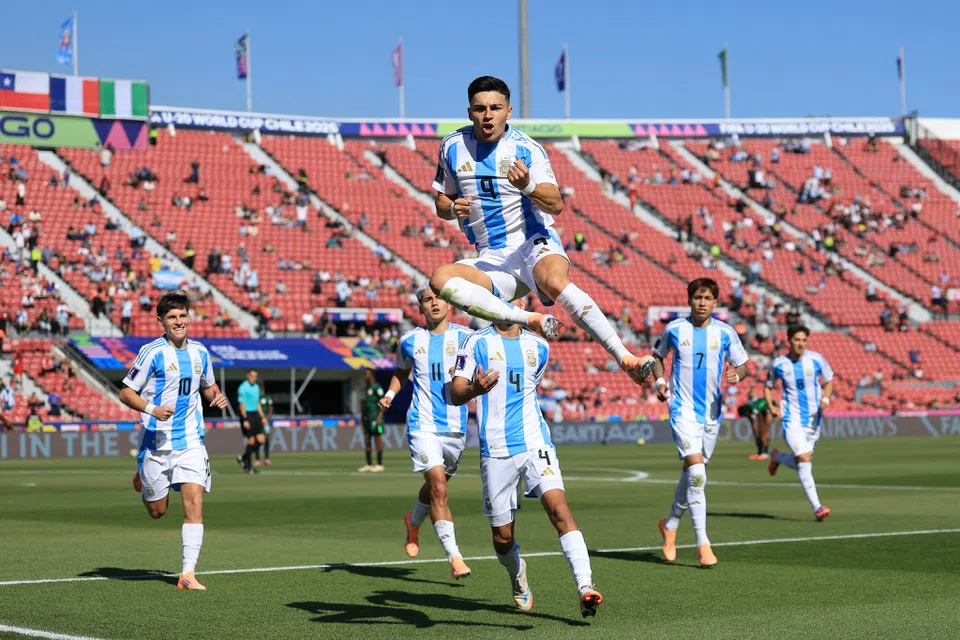The Nigeria vs Argentina FIFA U-20 World Cup match in Santiago delivered a stark reality check for the Flying Eagles, as Argentina ran out 4-0 winners in a round of 16 tie at the Estadio Nacional in Chile. From the opening minute to the final whistle, the South American side controlled every phase, and the Nigerians never found rhythm, timing, or belief.
There was an ominous sign almost immediately. Inside 65 seconds, Alejo Sarco met a precise Dylan Gorosito cross to score what one report called the fastest goal of the tournament, and from there Argentina played with poise and purpose while Nigeria struggled to reset. The early punch drained energy from the Flying Eagles and lifted an Argentinian team already brimming with confidence.
The night in Santiago and the early shock
Nigeria came into this knockout clash after a mixed group stage, a 3-2 win over Saudi Arabia sandwiched between a loss to Norway and a 1-1 draw with Colombia, which was enough to reach the round of 16 as one of the best third-placed teams. Those inconsistencies resurfaced, and against a relentless Argentina, any lapse was punished with clinical finishing.
By the 23rd minute, Maher Carrizo doubled the lead with a moment of class. A well struck free kick, low and bending into the corner, beat a static wall and left Ebenezar Harcourt with no chance. At that point the scoreline matched the flow, Argentina were quicker in transition and calmer in possession, while Nigeria chased shadows.
How the goals came
Sarco strikes inside two minutes
Argentina did not wait to ask questions, they imposed themselves from the first whistle. Sarco’s early finish from Gorosito’s delivery set the tone, and the Flying Eagles, who had barely strung two passes together, were forced to climb a steep hill against an opponent that pressed intelligently and passed with precision.
Carrizo brilliance before and after the break
Carrizo’s first came on 23 minutes and it captured the discipline in Argentina’s set plays, a cleanly executed free kick that punished Nigeria’s hesitation. After halftime, another Nigerian giveaway in midfield offered Carrizo a second opening in the 53rd minute, and he accepted it with a composed strike that made it 3-0 and effectively ended the contest.
Silvetti seals it with style
The fourth goal was crafted with flair. Substitute Mateo Silvetti isolated his marker, Daniel Bameyi, then created a pocket of space and curled in a delightful finish in the 66th minute. In the sequence, Gianluca Prestianni provided the assist, and the movement highlighted Argentina’s variety in attack, from set piece quality to open play craft.
Argentina show the standard
Argentina arrived in Chile with pedigree and momentum, and they confirmed why they remain among the favorites, a record six U-20 World Cup titles underscore that status. They were ruthless in both penalty areas, they managed the tempo, and they played with a confidence that never wavered once Sarco opened the scoring.
Every line of the team functioned, the press was coordinated, the midfield recycled possession with minimal fuss, and the forwards attacked space with intent. In knockouts, control and clarity often decide games, and Argentina had both in abundance.
Where Nigeria fell short
The Flying Eagles struggled with defensive shape and ball security. Key turnovers in central areas, particularly before the third goal, revealed the lack of a reliable outlet when under pressure. Without clean exits and with minimal threat between the lines, Nigeria could not connect midfield to attack.
Set pieces became a pressure point as well. Carrizo’s free kick was a lesson in detail and preparation, and it magnified Nigeria’s difficulties in positioning and reaction. In a game of margins, those moments define the narrative, and here they widened the gap.
The bigger picture for Nigerian football
The loss felt heavier than a bad day at the office. Nigerian fans have heard this refrain before, individual talent is evident, yet the structure that polishes and prepares that talent often lags behind. As one analysis argued, the system shows faults in youth development, tactical consistency, psychological readiness, and leadership, and on a night like this, the cracks were visible to all.
This is not to dismiss the quality of the opposition. Argentina were excellent, but the manner of defeat invites hard questions about pathways, coaching continuity, and tournament preparation. The U-20 team is a snapshot of processes beneath the senior level, and when those processes falter, the symptoms appear on big stages.
It was not just a loss, it was a comprehensive defeat that demanded accountability and a plan, not platitudes.
Context from the group stage to the knockout blow
Nigeria’s tournament arc offered early clues. A narrow win over Saudi Arabia, then a draw with Colombia, hinted at resilience but also at vulnerabilities in control and finishing. The loss to Norway in the opener set a delicate tone, and by the time Argentina arrived, there was little margin for error.
In contrast, Argentina’s form was spotless to this point, unbeaten and confident, and it showed in the way they managed minutes after the early goal. The contrast between the teams, one learning on the fly and the other executing with certainty, was the thread that ran through the match.
What the result means for both teams
For Argentina, the reward is a quarterfinal meeting with Mexico, a fixture that promises intensity and technical quality. For Nigeria, it is an abrupt end and the need for reflection on the road ahead.
- Argentina continue their perfect run, confidence high and combinations sharp,
- Nigeria exit at the round of 16, their inconsistencies finally catching up,
- the quarterfinal bracket gains a heavyweight, and a football nation faces difficult questions.
Key moments that shaped the night
First, the start that stunned Nigeria. Conceding inside two minutes rattled the team and set a tactical trap, Argentina could wait for errors while keeping the ball, and Nigeria were forced to chase.
Second, the set piece mastery. Carrizo’s technique on the free kick, coupled with Argentina’s well rehearsed routines, highlighted one team’s preparation and another’s uncertainty.
Third, the turnover before 3-0, a single mistake that told a larger story about pressure management and decision making under stress.
Individual notes on the protagonists
Alejo Sarco showed a striker’s instinct with his early run and finish. For a young forward, timing and movement inside the box are precious commodities, and Sarco’s start set the emotional and tactical baseline for the match.
Maher Carrizo’s brace spoke to range and composure, a dead ball strike for the second goal and a measured finish for the third. The variety in his scoring emphasized the depth of Argentina’s toolkit.
Mateo Silvetti, introduced from the bench, produced the exclamation point with an assured curler. The contribution of substitutes matters in tournaments, and Silvetti delivered in style.
Tactical layers and turning points
Argentina’s press funneled Nigeria toward the touchlines, where traps could be sprung and counters launched. This narrowed the passing lanes and left the Flying Eagles playing predictable balls that were easy to anticipate.
When Nigeria did try to compress the field to shut down Argentina’s midfield, the South American side rotated smoothly, often using the fullback and wide forward to escape pressure. That balance, secure at the base and lively up front, ensured the game stayed at Argentina’s tempo.
The mental game and the weight of the first goal
At youth level, momentum is more than a concept, it is a force. Conceding what was described as the fastest goal of the tournament created a psychological deficit that was difficult to erase. Every missed touch and every late tackle compounded the stress.
Argentina, meanwhile, played as if the early goal unlocked muscle memory. Confidence can be contagious within a team, and each successful action built rapport and rhythm. The fourth goal was not necessary to win, but it reflected the freedom Argentina felt to keep expressing their game.
Lessons for the Flying Eagles
There is no shortage of pride or potential in Nigerian football, but potential without structure can drift. The takeaways from this defeat are practical, better rehearsed set piece defense, clearer midfield exit routes under pressure, and a more cohesive plan for transitions.
Preparation is not only about fitness and formation, it is also about psychological resilience and tactical adaptability. The next cycle should focus on longer camps, consistent tactical frameworks across age groups, and targeted mentorship for players in key decision zones on the pitch.
What comes next
Argentina move on with a date against Mexico, and with the belief that accompanies a perfect record. Their blend of timing, technique, and tactical order gives them a strong platform as the stakes rise.
Nigeria return home with bruises and with a responsibility to act. The disappointment will sting, yet it can be a catalyst if the right conversations lead to tangible steps. The vision must match the ambition, and the execution must match the talent.
Final verdict
Argentina 4-0 Nigeria was a scoreboard that matched the story, Argentina’s clarity met Nigeria’s uncertainty, and the result reflected that gulf. The Flying Eagles have work to do, but there is still a path if lessons are taken and systems are strengthened.
For now, the quarterfinal path belongs to Argentina, and the soul searching belongs to Nigeria. The U-20 stage is as much about identity as it is about results, and on this night in Chile, one team knew exactly who they were, and the other must decide who they want to become.






